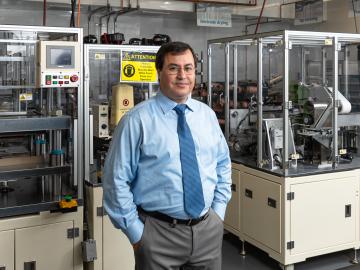
Filter News
Area of Research
- (-) Energy Science (67)
- (-) Supercomputing (10)
- Advanced Manufacturing (4)
- Biology and Environment (34)
- Building Technologies (2)
- Computational Biology (1)
- Computational Engineering (2)
- Computer Science (6)
- Energy Sciences (2)
- Fusion and Fission (2)
- Fusion Energy (7)
- Isotopes (1)
- Materials (17)
- Materials for Computing (3)
- Mathematics (1)
- National Security (6)
- Neutron Science (29)
- Nuclear Science and Technology (7)
- Nuclear Systems Modeling, Simulation and Validation (1)
- Transportation Systems (1)
News Type
News Topics
- (-) Advanced Reactors (1)
- (-) Artificial Intelligence (2)
- (-) Energy Storage (32)
- (-) Neutron Science (1)
- (-) Security (2)
- (-) Summit (7)
- 3-D Printing/Advanced Manufacturing (33)
- Big Data (7)
- Bioenergy (4)
- Biology (4)
- Biomedical (6)
- Biotechnology (1)
- Buildings (19)
- Chemical Sciences (2)
- Clean Water (5)
- Composites (9)
- Computer Science (27)
- Coronavirus (8)
- Critical Materials (8)
- Cybersecurity (2)
- Environment (25)
- Exascale Computing (2)
- Frontier (2)
- Fusion (1)
- Grid (20)
- High-Performance Computing (6)
- Hydropower (2)
- Machine Learning (3)
- Materials (16)
- Materials Science (11)
- Mathematics (2)
- Mercury (2)
- Microscopy (3)
- Nanotechnology (2)
- National Security (1)
- Nuclear Energy (2)
- Polymers (7)
- Quantum Computing (4)
- Quantum Science (4)
- Simulation (3)
- Space Exploration (3)
- Statistics (1)
- Transportation (36)
Media Contacts

Oak Ridge National Laboratory researchers have developed a thin film, highly conductive solid-state electrolyte made of a polymer and ceramic-based composite for lithium metal batteries.

Researchers at Oak Ridge National Laboratory demonstrated a 20-kilowatt bi-directional wireless charging system on a UPS plug-in hybrid electric delivery truck, advancing the technology to a larger class of vehicles and enabling a new energy storage method for fleet owners and their facilities.

Ilias Belharouak is leading ORNL’s research efforts in investigating new materials for solid-state batteries, which can double the charging capacity of lithium-ion batteries, commonly used today for electronic devices such as cell phones.

Researchers at ORNL demonstrated that sodium-ion batteries can serve as a low-cost, high performance substitute for rechargeable lithium-ion batteries commonly used in robotics, power tools, and grid-scale energy storage.

A novel approach developed by scientists at ORNL can scan massive datasets of large-scale satellite images to more accurately map infrastructure – such as buildings and roads – in hours versus days.

The prospect of simulating a fusion plasma is a step closer to reality thanks to a new computational tool developed by scientists in fusion physics, computer science and mathematics at ORNL.

Oak Ridge National Laboratory researchers created a geothermal energy storage system that could reduce peak electricity demand up to 37% in homes while helping balance grid operations.

To better determine the potential energy cost savings among connected homes, researchers at Oak Ridge National Laboratory developed a computer simulation to more accurately compare energy use on similar weather days.

A new method developed at Oak Ridge National Laboratory improves the energy efficiency of a desalination process known as solar-thermal evaporation.

A team of researchers at Oak Ridge National Laboratory have demonstrated that designed synthetic polymers can serve as a high-performance binding material for next-generation lithium-ion batteries.


